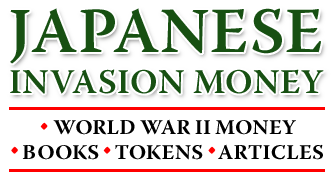Reviewed by Andrew Crellin
An essential guide for this historic and fascinating series.
I believe this is one of the finest books published on any Australian numismatic subject in the past decade at least - it has clearly been thoroughly researched, the information is superbly presented, and the series is rich in social history. The author has paid keen attention to the technical information included in it, and clearly has a passion for the subject.
Japanese Invasion Money (JIM) is the term used to describe the currency notes printed by the Japanese Military Authority during World War II, for use in the countries in South East Asia and the Pacific that it invaded over the course of the war.
It has long been a keenly collected series by a devout few, and is rich in social history. The availability of JIM notes ranges very widely - the cheapest can be worth a few cents apiece, while the rarest items can be worth thousands of dollars IF you're able to spot one.
I'd suggest that while many Australian note collectors would have a passing interest in these notes at least, they would have been put off due to the opaque nature of the series - it hasn't been clear how many different notes were printed, how many different varieties of each note exist, and how rare the notes are. I believe this book will answer many of those questions, and that demand for the notes will increase significantly as a result, even if only on a social level.
Before this book was published, I believe it's fair to say that information on JIM notes has been published piece-meal, with many little bits of information spread across a wide range of disparate sources.
JIM covers several countries and collectors markets, and while certain numismatic authors may have covered the JIM notes printed for use in their own country, to date there hasn't been one single book that covers each area of JIM in deep detail.
This book addresses each of those factors, and I believe the market will respond accordingly.
If I have one criticism of the book it is the pricing guide - it doesn't make any damn sense! I'm a big believer in numismatic price guides using fair market values in their books - "...the estimated amount for which these items should exchange on the date of valuation between a willing buyer and a willing seller in an arm's length transaction, after proper marketing, wherein the parties had each acted knowledgeably, prudently and without compulsion." Yes, that is a verbose description of what kind of price should be included in a price guide, but I hope you get my drift.
When they look an item up in a price guide, the question the average collector wants answered is "How much is this going to cost me?" The unfortunate thing is that I'm not confident that the prices of many of the notes in this guide meet that mark.
It took me a while to understand the logic behind the figures published, however after a while I worked it out. EF seems to be the base grade for each note - a value has been allocated to each note in that grade, then a factor (ranging between 5% and 25%) has been either added to it, or subtracted from it. All good and well in logic, however in reality not all that practical.
By way of example, a particular note may have a base value in Extremely Fine of $3.90, which means about Unc is $4.68, and Uncirculated is $5.65! I've been in the market long enough to know that collectors and certainly dealers don't go down to double digit pricing for numismatic items, except when talking grams of precious metals.
A more practical price guide would use whole dollar amounts, and while a Very Good note may not have the same appeal as a Very Fine note, they may actually trade for around the same price - if you can get a Very Fine note instead of a Very Good note for the same money, all good and well.
This gripe really is minor however in the broader context of the project - this market is still raw enough that prices are going to get made up along the way regardless, while the value of the information in the book, coupled with the superb presentation and the social history means it is still an excellent resource (and read!) regardless.
 If you have any interest at all in Australian numismatics, I strongly suggest you get a copy of this book.
If you have any interest at all in Australian numismatics, I strongly suggest you get a copy of this book.
JIM notes are an affordable and historic series - they're perfect for the collector working to a budget, as well as the collector keen to sink their teeth into a set that is going to challenge their grey matter and detective skills.
This fantastic book will make an excellent companion.

